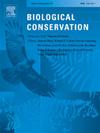小型哺乳动物对规定的低强度火灾的反应:来自澳大利亚北部火灾实验的遗传见解
IF 4.9
1区 环境科学与生态学
Q1 BIODIVERSITY CONSERVATION
引用次数: 0
摘要
以生物多样性保护为具体目标,在稀树草原生境管理中广泛使用规定的火。然而,对确定物种对火灾的反应和在火灾易发环境中的持久性的机制的理解很少支持这一观点。在澳大利亚北部的热带稀树草原上进行了一项火灾实验,研究了不同火灾频率地区三种小型哺乳动物对火灾的人口统计学和遗传反应。在实验烧伤前(火灾前)、火灾后6周和火灾后1年进行了现场诱捕调查。对于每个物种,我们测试了个体数量、捕获率、表观存活率和临时迁移、遗传多样性、遗传结构和亲缘关系的空间模式的变化。高火频区捕获北方褐土鼬(Isoodon macrus)和北方帚尾负鼠(Trichosurus vulpecula arhemensis)较多,低火频区捕获黑足树鼠(Mesembriomys gouldii melvillensis)较多。低强度火灾事件对任何物种的任何人口统计学或遗传指标都没有直接影响。然而,有证据表明,物种特有的扩散动力学,遗传相关的北方棕色土鼬比其他物种更分散,特别是在火灾发生后的6周。遗传上有亲缘关系的北方帚尾负鼠和黑足树鼠大多占据了相同的地块,没有受到火灾的影响。该研究表明,澳大利亚北部旱季早期火灾管理计划中的低强度火灾事件对这些小型哺乳动物种群的直接影响最小,但长期火灾频率的异质性对于为多种物种提供栖息地至关重要。然而,不经常被烧毁的栖息地越来越少,但对一些衰落的物种,如黑足树鼠,却很重要。因此,我们建议考虑具有不同栖息地要求和生活史的共生物种所需的栖息地特征的战略长期火灾管理。本文章由计算机程序翻译,如有差异,请以英文原文为准。
Responses of small mammals to prescribed low-intensity fire: Genetic insights from a northern Australian fire experiment
Prescribed fire is widely used for habitat management in savannas, with biodiversity conservation as a specific objective. However, it is rarely underpinned by an understanding of the mechanisms determining species' responses to fire and persistence in fire-prone environments. We conducted a fire experiment in a mesic northern Australian savanna to investigate the demographic and genetic responses of three small mammal species to fire in areas with different fire frequencies. Live-trapping surveys were conducted before the experimental burns (pre-fire), six-weeks post-fire, and one-year post-fire. For each species, we tested for changes in the number of individuals, capture rates, apparent survival and temporary emigration, genetic diversity, genetic structure, and spatial patterns of relatedness.
More northern brown bandicoots (Isoodon macrourus) and northern brushtail possums (Trichosurus vulpecula arnhemensis) were captured in high fire frequency plots, whereas more black-footed tree-rats (Mesembriomys gouldii melvillensis) were captured in low fire frequency plots. There was no direct effect of the low-intensity fire event on any demographic or genetic metric for any species. However, there was evidence of species-specific dispersal dynamics, with genetically related northern brown bandicoots more dispersed than the other species, especially six-weeks post-fire. Genetically related northern brushtail possums and black-footed tree-rats mostly occupied the same plots with no effect of fire.
This research shows that low intensity fire events within early dry season fire management programs in northern Australia have minimal direct impact on populations of these small mammal species but heterogeneity in long-term fire frequency is important for providing habitat for diverse species. However, infrequently burnt habitat is increasingly rare but important for some declining species like the black-footed tree-rat. We therefore recommend strategic long-term fire management that considers the habitat characteristics required for co-occurring species with distinct habitat requirements and life-histories.
求助全文
通过发布文献求助,成功后即可免费获取论文全文。
去求助
来源期刊

Biological Conservation
环境科学-环境科学
CiteScore
10.20
自引率
3.40%
发文量
295
审稿时长
61 days
期刊介绍:
Biological Conservation is an international leading journal in the discipline of conservation biology. The journal publishes articles spanning a diverse range of fields that contribute to the biological, sociological, and economic dimensions of conservation and natural resource management. The primary aim of Biological Conservation is the publication of high-quality papers that advance the science and practice of conservation, or which demonstrate the application of conservation principles for natural resource management and policy. Therefore it will be of interest to a broad international readership.
 求助内容:
求助内容: 应助结果提醒方式:
应助结果提醒方式:


